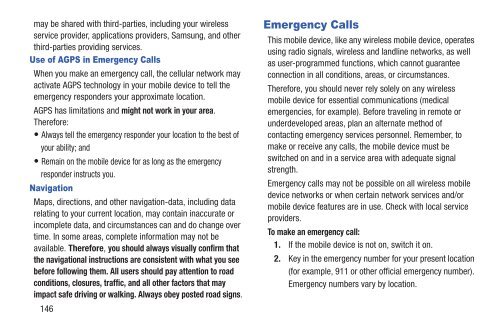Samsung Gusto 2 128MB (Verizon) - SCH-U365WSAVZW - User Manual ver. FB03_F6 (ENGLISH(North America),3.36 MB)
Samsung Gusto 2 128MB (Verizon) - SCH-U365WSAVZW - User Manual ver. FB03_F6 (ENGLISH(North America),3.36 MB)
Samsung Gusto 2 128MB (Verizon) - SCH-U365WSAVZW - User Manual ver. FB03_F6 (ENGLISH(North America),3.36 MB)
You also want an ePaper? Increase the reach of your titles
YUMPU automatically turns print PDFs into web optimized ePapers that Google loves.
may be shared with third-parties, including your wireless<br />
service provider, applications providers, <strong>Samsung</strong>, and other<br />
third-parties providing services.<br />
Use of AGPS in Emergency Calls<br />
When you make an emergency call, the cellular network may<br />
activate AGPS technology in your mobile device to tell the<br />
emergency responders your approximate location.<br />
AGPS has limitations and might not work in your area.<br />
Therefore:<br />
• Always tell the emergency responder your location to the best of<br />
your ability; and<br />
• Remain on the mobile device for as long as the emergency<br />
responder instructs you.<br />
Navigation<br />
Maps, directions, and other navigation-data, including data<br />
relating to your current location, may contain inaccurate or<br />
incomplete data, and circumstances can and do change o<strong>ver</strong><br />
time. In some areas, complete information may not be<br />
available. Therefore, you should always visually confirm that<br />
the navigational instructions are consistent with what you see<br />
before following them. All users should pay attention to road<br />
conditions, closures, traffic, and all other factors that may<br />
impact safe driving or walking. Always obey posted road signs.<br />
146<br />
Emergency Calls<br />
This mobile device, like any wireless mobile device, operates<br />
using radio signals, wireless and landline networks, as well<br />
as user-programmed functions, which cannot guarantee<br />
connection in all conditions, areas, or circumstances.<br />
Therefore, you should ne<strong>ver</strong> rely solely on any wireless<br />
mobile device for essential communications (medical<br />
emergencies, for example). Before traveling in remote or<br />
underdeveloped areas, plan an alternate method of<br />
contacting emergency services personnel. Remember, to<br />
make or receive any calls, the mobile device must be<br />
switched on and in a service area with adequate signal<br />
strength.<br />
Emergency calls may not be possible on all wireless mobile<br />
device networks or when certain network services and/or<br />
mobile device features are in use. Check with local service<br />
providers.<br />
To make an emergency call:<br />
1. If the mobile device is not on, switch it on.<br />
2. Key in the emergency number for your present location<br />
(for example, 911 or other official emergency number).<br />
Emergency numbers vary by location.
















